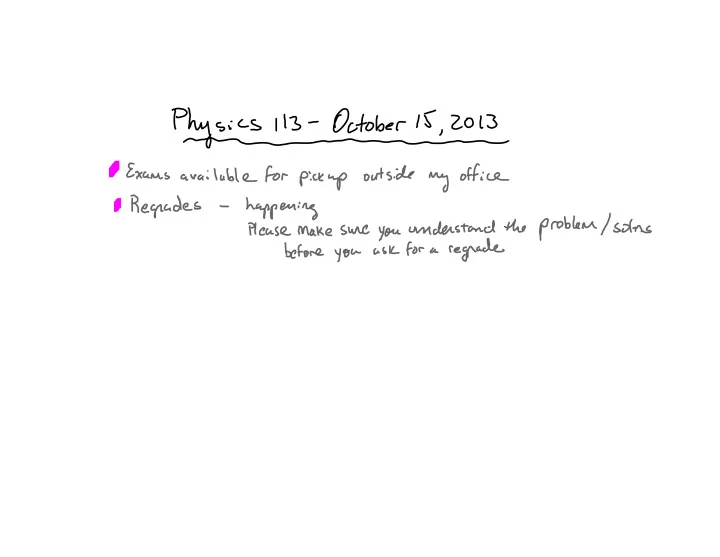

Example: The simple pendulum Suppose we release a mass m from rest a distance h 1 above its lowest possible point. What is the maximum speed of the mass and where does this happen? To what height h 2 does it rise on the other side? m h 1 h 2 v
Example: The simple pendulum Kinetic+potential energy is conserved since gravity is a conservative force ( E = K + U is constant) Choose y = 0 at the bottom of the swing, and U = 0 at y = 0 (arbitrary choice) E = 1 / 2 mv 2 + mgy y h 1 h 2 y = 0 v
Example: The simple pendulum E = 1 / 2 mv 2 + mgy . Initially, y = h 1 and v = 0 , so E = mgh 1 . Since E = mgh 1 initially, E = mgh 1 always since energy is conserved. y y = 0
Example: The simple pendulum 1 / 2 mv 2 will be maximum at the bottom of the swing. So at y = 0 1 / 2 mv 2 = mgh 1 v 2 = 2gh 1 v 2 gh 1 y y = h 1 h 1 y = 0 v
Example: The simple pendulum 1 / 2 mv 2 + mgy it is clear that the maximum Since E = mgh 1 = height on the other side will be at y = h 1 = h 2 and v = 0 . The ball returns to its original height. y y = h 1 = h 2 y = 0
Example: The simple pendulum The ball will oscillate back and forth. The limits on its height and speed are a consequence of the sharing of energy between K and U . E = 1 / 2 mv 2 + mgy = K + U = constant . y
Generalized Work/Energy Theorem: W NC = K + U = E mechanical The change in kinetic+potential energy of a system is equal to the work done on it by non-conservative forces. E mechanical =K+U of system not conserved! If all the forces are conservative, we know that K+U energy is conserved: K + U = E mechanical = 0 which says that W NC = 0. If some non-conservative force (like friction) does work, K+U energy will not be conserved and W NC = E .
Problem: Block Sliding with Friction A block slides down a frictionless ramp. Suppose the horizontal (bottom) portion of the track is rough, such that the coefficient of kinetic friction between the block and the track is k . How far, x , does the block go along the bottom portion of the track before stopping? k d x
Problem: Block Sliding with Friction... Using W NC = K + U As before, U = -mgd W NC = work done by friction = - k mgx . K = 0 since the block starts out and ends up at rest. W NC = U - k mgx = -mgd x = d / k k d x
Recommend
More recommend